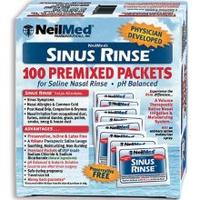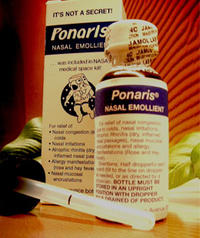The process of actually rinsing out the nasal and sinus passages is probably more important that what you rinse with. The following options are available.
Make your own saline rinse
See our saline recipe.
Antibacterial irrigations
 Wilson’s solution, a combination of Gentamycin or Tobramycin and normal saline solution, is the classic antibiotic irrigation. 160mg Gentamycin in 1 L of NS is the standard solution. Bactroban ointment is a water soluble substance, which can be readily dissolved in saline. Typically we use 22 grams of 2% ointment in one liter of normal saline (1 1/2 to 2 inches of ointment in a neilmed rinse kit) and have patients irrigate for four to six weeks as needed. Any ear drop or eye drop is safe to use, and we often use them perioperatively. However, they cost-prohibitive.
Wilson’s solution, a combination of Gentamycin or Tobramycin and normal saline solution, is the classic antibiotic irrigation. 160mg Gentamycin in 1 L of NS is the standard solution. Bactroban ointment is a water soluble substance, which can be readily dissolved in saline. Typically we use 22 grams of 2% ointment in one liter of normal saline (1 1/2 to 2 inches of ointment in a neilmed rinse kit) and have patients irrigate for four to six weeks as needed. Any ear drop or eye drop is safe to use, and we often use them perioperatively. However, they cost-prohibitive.
Antifungal irrigations
The Mayo Clinic has popularized using Amphotericin B 100-250 micrograms/ml of sterile water as an irrigation solution. The stability and efficacy have been questioned, but it seems promising. A reasonable option would be to place 2 50 mg IV vials of Ampho B in 1 liter of distilled water and irrigate each nostril with 20 cc of solution twice a day. Itraconazole (Sporanox), Lamisil, or Diflucan can also be made into a nasal rinse. The Amphotericin nasal rinse needs to be refrigerated, is in sterile water, and has been reported to be difficult to tolerate by many patients. Lamisil and Sporanox are both very expensive.
Ponaris Nasal Emollient
 This cold season reach for all-natural Ponaris to relieve your stuffy, congested nose, postnasal drip, and nasal dryness, just as folks have done since 1931.
This cold season reach for all-natural Ponaris to relieve your stuffy, congested nose, postnasal drip, and nasal dryness, just as folks have done since 1931.Once standard in NASA’s medical space kit, this effective formula contains oils of pine, eucalyptus, peppermint, cajeput, and cottonseed. Just a half dropper into each nostril is all it takes to get the job done.
Ponaris is a compound of carefully selected mucosal lubricating and moisturizing botanical oils, specially treated through the exclusive J-R iodization process since 1931.
Adjunctive topical nasal measures
Other rinses with moisturizing properties exist, such as:
- Nasovisc is another natural formulation often used for dry nose
- Blairex, Nose Better, Ponaris, Pretz-d, Nasal Moist, and Rhinaris are all moisturizing sprays
- Entertainer’s Secret spray is a special formulation used as a throat spray that some have used as a nasal moisturizer
- Capsaicin is the agent which makes hot pepppers hot, and can help open up the nasal and sinus passages as well as stimulate the secretion of mucous (available as a pre-made spray at www.sinusbuster.com)
- Vicks vaporub is also helpful but be careful not to inhale it, as it is fat soluble and could precipitate lipid pneumonia
- Estrogen cream has been used by some for its hormonal effects
- Alkalol is a commercially available solution with a menthol flavoring which is helpful to many
- Singulair (two 10mg tabs dissolved in 4 oz of enhanced nasal moisturizer solution) sprayed in the nose has been advocated by the University of Pennsylvania ( www.entconsult.com)
- Sinofresh is one which contains glycerin and also posesses antibiotic and antifungal properties
- UPENN has also recommended dissolving Benadryl (50mg tabs in 4 oz of saline) in saline and rinsing the nose three times a day
- Lactated ringers is a commonly used intravenous fluid solution, which some feel is less toxic to the nasal mucosa than saline
- Johnsons Baby Shampoo. Biofilms are essentially thick tenacious snot that protects bacteria and fungi from the effects of antimicrobials and irrigants. It has been hypothesized that the use of 1% Johnsons baby shampoo (1/2 tsp in 1 NeilMed Sinus Rinse bottle bid) helps emulsify the biofilms and allows for irrigation and removal of the offending organisms. It is essentially a detergent or surfactant that allows for the dissolution of the thick ropy mucous and crusting. (2 tsp in 1 liter of NS, irrigate each nostril with 125 ml twice a day)
- Pulmicort Respules 0.5mg/2cc in 250cc NS. I have seen remarkable resolution of polypoid mucosa with this solution. (irrigate each nostril with 125 ml twice daily)
- Betadine 10 cc in 1 L of NS (can stain, and is to be avoided is iodine allergic)
- Acetic Acid 1 oz in 16 oz of NS
- Lasix IV in NS has been reported to diminish polyps